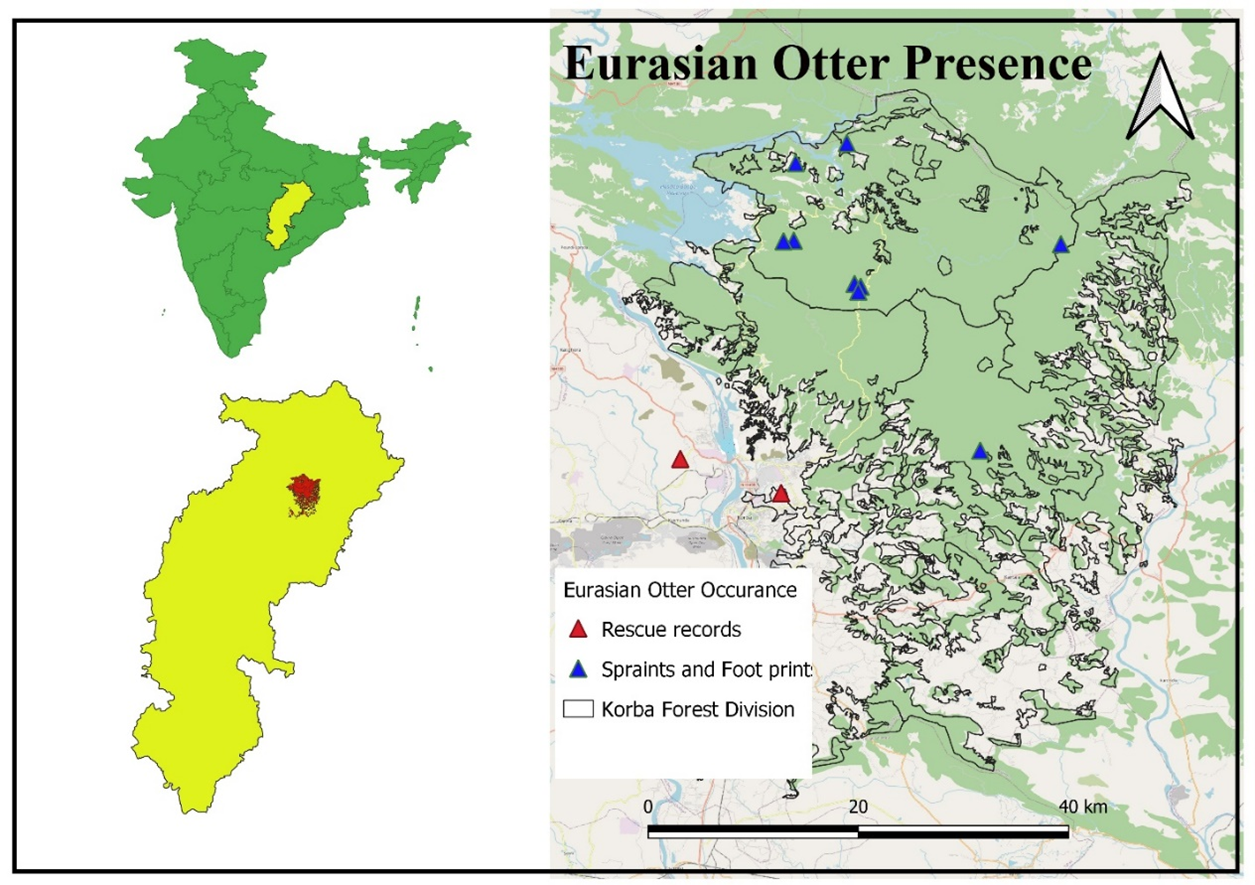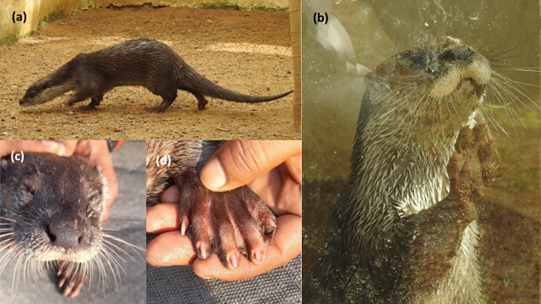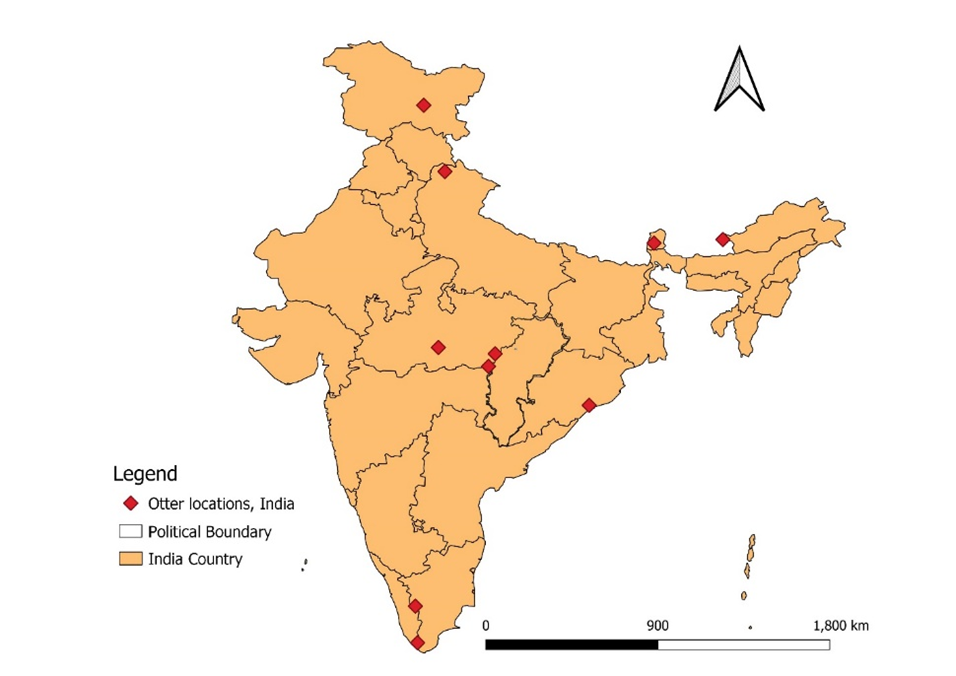IUCN/SSC Otter Specialist Group Bulletin

©IUCN/SCC Otter Specialist Group
Volume 39 Issue 4 (November 2022)
Citation: Suraj, M., Ahmed, M., Basak, K., Sarathi, J., Pandey, P., and Khelwar, A. (2022). First Record of Eurasian Otter (Lutra lutra) from Chhattisgarh, Central India. IUCN Otter Spec. Group Bull. 39 (4): 229 - 235
First Record of Eurasian Otter (Lutra lutra) from Chhattisgarh, Central India
Mat Suraj1*, Moiz Ahmed1, Krishnendu Basak1, Jitendra Sarathi1, Priyanka Pandey2, and Ashish Khelwar1
1Nova Nature Welfare Society, 36/337, Behind Chhoti Masjid, Byron Bazar, Raipur Chhattisgarh 492001, India
2Chhattisgarh Forest Department, Korba forest division, Chhattisgarh, India
*Corresponding Author Email: mat.suraj@gmail.com
(Received 23rd May 2022, accepted 23rd August 2022)
Abstract: The Eurasian otter Lutra lutra is one of the three species of otters found in Indian rivers. Ten different studies reported its presence with photographic evidences and captured individuals from seven different states in India. These studies reflect the distribution of Eurasian otters from North, Northwestern and Northeastern Himalayas, Eastern coastal India, southern Western Ghats to Satpura-Maikal range of Central India, all located at separate location on the subcontinent. We report the presence of Eurasian otter (Lutra lutra) first time with photographic confirmation from Chhattisgarh, 200 km away from the nearest known location in Kanha Tiger Reserve, Madhya Pradesh, and confirms a geographical range extension of the Eurasian otter in Central India. New records suggest that the species may yet be present in other locations across India. The Eurasian otter is in urgent need of intensive study in their distribution range in order to elevate their protection by scientific and management authorities.
Keywords:Eurasian otter, Central India, Chhattisgarh
INTRODUCTION
The Eurasian otter Lutra lutra (Linnaeus, 1758) is the most widely distributed species of all 13 otter species in the world, ranging throughout Eurasia. In the Indian subcontinent, Eurasian otter shares its habitat with the Smooth-coated otter (Lutrogale perspicillata I. Geoffroy Saint-Hilaire, 1826) and the Small-clawed otter (Aonyx cinereus Illiger, 1815). There are very patchy distribution records in India and very few studies exist to describe their status and ecology in the country. Records of Eurasian otter are available in the Himalayas along the north of India, extended from northwest to northeastern parts (Jamwal et al., 2016; Bhattacharya et al., 2019; Khatiwara and Bhutia, 2020; Pal et al., 2021; Borker et al., 2022; Savage, 2022) that included Jammu and Kashmir, Uttarakhand, Sikkim and Arunachal Pradesh, and in south India records are available yet in the southern Western Ghats only (Pocock, 1949; Prater, 1980; Foster-Turley and Santiapillai, 1990; Hussain and Choudhury, 1997). Photographic evidence is available from recent camera trap studies from Central India (Jena et al., 2016; Joshi et al., 2016; Uikey, 2021) Western Ghats, Tamil Nadu (Mudappa et al., 2018), Ladakh (Jamwal et al., 2016), Nyamjang Chu river and Pakke Tiger Reserve, Arunachal Pradesh (Bhattacharya et al., 2019; Borker et al., 2022), Chilika Lake, Odisha (Adhya and Dey, 2020) and from Bhagirathi Basin, Uttarakhand (Pal et al., 2021). The species is categorized as Near Threatened on IUCN Red List (Roos et al., 2015). European populations are well characterized and are increasing in some countries, but in many parts of their range populations have gone extinct or are declining, or the trend is largely unknown (Chanin, 2003).
In this paper we report the presence of Eurasian otter for the first time in the State of Chhattisgarh from Korba and Kathghora Forest Division, Central India. A survey recorded photographs and indirect signs as scats and tracks during a study from September to November, 2021. The photographs were taken of rescued Eurasian otters obtained from the study area. Otters were found to use forested and non-forested areas of these forest divisions which were often dominated by various anthropogenic activities ranging from the release of effluents in otter habitats from thermal power and mining units to hunting of otter for consumption by local fisherman communities. Our report thus describes presence of Eurasian otters from Korba and Kathghora Forest Division of Chhattisgarh and also areas outside the forest and in a need of protection or regular vigilance to give the species a safe habitat to thrive.
Korba Forest Division in Korba District lies between 22° 01’–23° 01’ N latitude and 82° 08’–83°09’ E longitude in the State of Chhattisgarh. Four prominent perennial rivers flow through the district, namely, Sonbhadra, Hasdeo, Ahiran, and Lilagar. Hasdeo Rivers originating from the Chhotanagpur Plateau in the Surguja District and flowing southwards. The climate of the district is tropical and usually hot and dry, until the southwest monsoon brings rain. The winters span from December to February, followed by summer from March to June. The South-West monsoon lasts from mid-June until September. The district has an average elevation of approximately 305 masl and receives an annual rainfall of 1507 mm. The majority of the region is a plateau of the Maikal Ranges of the Satpura Hills. The main forest types found in this area is moist peninsular Sal forest, moist mixed deciduous forest, dry peninsular Sal forest and northern dry mixed deciduous forest which is also common in adjacent Kathghora Division. The availability of coal in the region has led to the construction of many power plants, which impact otter habitat.
Methodology
We collected opportunistic evidence of otters from the surveyed grids of a King Cobra survey during the post-monsoon and early winter seasons. The Korba Forest area was divided into forty-five grids, each 25 km2 in size, primarily in forest habitats. In each grid a trail of 5 km was sampled, where a four-member team searched for King cobras and other snake species for about five hours per day. Indirect otter sign was observed, and their GPS locations were noted (Fig 1).

At a later date, we came to know about the rescue cases of two otters from Kathghora Division, adjacent to Korba Forest division. One of them was held at Jungle Safari in Raipur and the other was rescued from the water filter plant of National Thermal Power Corporation, Kathghora Division and sent to Kanan Pindari Zoological Park, Bilaspur in Chhattisgarh. The photographs of the otters were obtained (Fig. 2) from the zoological parks and identified based on field guides and research articles (Menon, 2014; Joshi et al., 2016; Mudappa et al., 2016).
RESULTS
Tracks and scats of Eurasian otter were found in fourteen locations. The indirect records were observed in rivers and streams flowing through sandy and rocky river banks flanked by Sal mixed forest. The two otters held at zoos adjacent to Kathghora Forest Division recorded the Eurasian otter for the first time in the State of Chhattisgarh (Fig 3). Otter signs was found from 383 masl to 561 masl. Species identification was based on the shape of muzzle, nostril, whiskers, coat, webbed and clawed feet, and conical tail.

DISCUSSION
We record new evidence of the geographical range of the Eurasian otters in the central Indian landscape. Until now nine photographic records of this species have been published for India (Fig 4). Two of these records of Eurasian otter were described from Satpura-Maikal range of Madhya Pradesh in Central India (Joshi et al., 2016; Uikey, 2021). Our records from Chhattisgarh are also situated in an extended part of the Maikal range, 200 km away from the nearest record of this species in Kanha Tiger Reserve, Madhya Pradesh.

All the photographic and capture records of Eurasian otters from seven different states in India, are located far from each other. It may be that Eurasian otter populations could be the remnants of a much wider former occupancy (Adhya and Dey, 2020), or that populations have not been detected until recently due to limited vigilance. Rising human populations and their increasing resource demands, may limit the success of otter populations in the future. The fishing and hunting communities in Korba Forest Division, revealed that they often kill and consume Eurasian otters. Otter living outside the forest of Kathghora Division is facing impacts from mining and thermal power units which commonly release effluents into rivers, degrading otter habitat. Eurasian otter populations outside protected areas, thus, remain outside the scope of any protection. Otter populations may have declined in the recent past, and those populations that still persist must be mapped and their conservation threats need to be assessed in order to create baseline data (Adhya and Dey, 2020). Much of the otter habitat in India has been intensively modified or has contaminated waterbodies (Bhattacharya et al., 2019). Intensive distribution studies and long-term monitoring of Eurasian otter prey species ecology, water parameters and threats to riparian habitats are needed in Chhattisgarh and across India.
Acknowledgements: We thank Mr. P.V. Narasingha Rao IFS (Principal Chief Conservator of Forest -Wildlife), Mr. C. Srinivas Rao IFS (Chief Executive Officer, CAMPA), Mr. Naveed Shujauddin IFS (Chief Conservator of Forest, Bilaspur), S. Jagadeesan IFS (Chief Conservator of Forest-Wildlife for providing the opportunity, support and guidance. It may not be possible to collect the data from such tough terrain without the support from Korba Forest Department and Faiz Bux and team including Devashish Rai, Rama Krishna Rapur from Nova Nature Welfare Society. We extend our sincere thanks for their efforts. We are grateful to the people from forest villages who assisted us with their immense knowledge of forests and wildlife.
REFERENCES
Adhya, T., Dey P. (2020). First record of Eurasian otter (Lutra lutra) from Chilika lagoon: A Ramsar Site situated on the East Coast of India. OTTER, Journal of the International Otter Survival Fund, 6: 49 – 55.
Bedford, S.J. (2009). The effects of riparian habitat quality and biological water quality on the European Otter (Lutra lutra) in Devon. Bioscience Horizons. 2 (2): 125-133. https://doi.org/10.1093/biohorizons/hzp015
Bhattacharya, M., Watham, T., Gopi, G.V. (2019). Photographic records of Eurasian otter (Lutra lutra Linnaeus, 1758) from Nyamjang Chu River, Arunachal Pradesh, India. IUCN Otter Spec Group Bull. 36 (2): 103–109. https://www.iucnosgbull.org/Volume36/Bhattacharya_et_al_2019.html
Borker, A., Gogi, K., Krupa, H., Savage, M., Bhardwaj, N. (2022). Otter Survey in Pakke Tiger Reserve, Arunachal Pradesh, Eastern Himalayas of India. IUCN Otter Spec. Group Bull. 39 (1): 29 – 38 https://www.iucnosgbull.org/Volume39/Borker_et_al_2022.html
Chanin P. (2003). Monitoring the Otter Lutra lutra. Conserving Natura 2000 Rivers Monitoring Series No. 10, English Nature, Peterborough. http://publications.naturalengland.org.uk/publication/78009
Dirzo, R., Young, S.H., Galetti, M., Ceballos, G., Isaac, N.J.B., Collen, B. (2014). Defaunation in the Anthropocene. Science. 345 (6195): 401-406. https://doi.org/10.1126/science.1251817
Easterson, D.C.V., Easha, P.S., Selvaraj, M. (2000). Effect of Thermal Power Plant effluents on the hydrological conditions in the Tuticorin Bay. Journal of marine biological association India. 42 (1&2): 135 –138. http://eprints.cmfri.org.in/1961/
Foster-Turley, P., & Santiapillai, C. 1990. Action plan for Asian otters, pp. 52 - 63 in Foster-Turley, P.A., Macdonald, S., and Mason, C. (eds.). Otters: An Action Plan for Their Conservation, IUCN, Gland, Switzerland.
Hussain, S.A., Choudhury, B.C. (1997). Distribution and status of the smooth-coated otter Lutra perspicillata in National Chambal Sanctuary, India. Biol. Conserv. 80: 199–206. https://doi.org/10.1016/S0006-3207(96)00033-X
Jamwal, PS, Takpa, J, Chandan, P and Savage, M (2016). First Systematic Survey for Otter (Lutra lutra) in Ladakh, Indian Trans Himalayas. IUCN Otter Spec. Group Bull. 33 (1): 79 - 85 https://www.iucnosgbull.org/Volume33/Jamwal_et_al_2016.html
Jena, J, Bhargava, D, Borah, J and Dey, S (2016). Notes on the Occurrence of the Eurasian Otter (Lutra lutra L.) in the Forest of Balaghat, Madhya Pradesh, India . IUCN Otter Spec. Group Bull. 33 (2): 59 – 63. https://www.iucnosgbull.org/Volume33/Jena_et_al_2016.html
Joshi, AS, Tumsare, VM, Nagar, AK, Mishra, AK and Pariwakam, MP (2016). Photographic Records of Eurasian Otter Lutra lutra from the Central Indian Landscape. IUCN Otter Spec. Group Bull. 33 (1): 73 - 78 https://www.iucnosgbull.org/Volume33/Joshi_et_al_2016.html
Khatiwara, S. and Bhutia, K.C. (2020). A Distribution Survey For Otters In Sikkim, India. IUCN Otter Spec. Group Bull. 37 (4): 212 - 218 https://www.iucnosgbull.org/Volume37/Khatiwara_Bhutia_2020.html
Macdonald and Chris Mason (Eds.) (1990). Otters, an action plans for their conservation. IUCN/SSC Otter Specialist Group. IUCN, Gland. 126 pp. https://doi.org/10.2305/IUCN.CH.1990.SSC-AP.3.en
Menon, V. (2014). Indian Mammals: A Field Guide. Hachette India, Gurgaon.
Mudappa, D, Prakash, N, Pawar, P, Srinivasan, K, Ram, MS, Kittur, S and Umapathy, G (2018). First Record of Eurasian Otter Lutra lutra in the Anamalai Hills, Southern Western Ghats, India. IUCN Otter Spec. Group Bull. 35 (1): 47 – 56 https://www.iucnosgbull.org/Volume35/Mudappa_et_al_2018.html
Pal, R., Sharma, A., Dubey, V.K., Bhattacharya, T., Jhonson, J.A., Sivakumar, K., Sathyakumar, S. (2021). A rare photographic record of Eurasian Otter Lutra lutra with a note on its habitat from the Bhagirathi Basin, western Himalaya, India. Journal of Threatened Taxa, 13 (13): 20072–20077. https://doi.org/10.11609/jott.6937.13.13.20072-20077
Pocock, R.I. (1949). The fauna of British India, including Ceylon and Burma. Volume 2, Mammals. Taylor and Francis, London 2: 265-317.
Prater, S. (1980). The Book of Indian Animals. Bombay Natural History Society, India.
Roos, A., Loy, A., de Silva, P., Hajkova, P., Zemanová, B. (2015). Lutra lutra. The IUCN Red List of Threatened Species 2015: eT12419A21935287. https://dx.doi.org/10.2305/IUCN.UK.2015-2.RLTS.T12419A21935287.en (accessed 28 March 2020).
Savage, M. (2022). Otters in Northeast India: A Review of the Sparse Available Information. IUCN Otter Spec. Group Bull. 39 (2): 81 – 89 https://www.iucnosgbull.org/Volume39/Savage_2022.html
Uikey, S.K. (2021). First Photographic Record of Eurasian Otter (Lutra Lutra) from Kanha National Park (M.P.) India. International Journal of Innovative Research and Advanced Studies. 8 (9): 7-9. https://www.ijiras.com/2021/Vol_8-Issue_9/paper_2.pdf
Yoxon, P., Yoxon, B. 2019. Eurasian otter (Lutra lutra): A review of the current world status. Otter, The Journal of the International Otter Survival Fund. 5, 53-73. https://www.academia.edu/44342002/EURASIAN_OTTER_Lutra_lutra_A_REVIEW_OF_THE_CURRENT_WORLD_STATUS
Résumé: Premier Enregistrement de la Loutre Eurasienne (Lutra lutra) dans le Chhattisgarh, au Centre de l’Inde
La loutre eurasienne Lutra lutra est l’une des trois espèces de loutres que l’on trouve dans les rivières indiennes. Dix études différentes rapportent sa présence avec des preuves photographiques et la capture des individus dans sept États différents en Inde. Ces études reflètent la distribution de la loutre eurasienne du nord, du nord-ouest et du nord-est de l’Himalaya, de la côte orientale de l’Inde, du sud des Ghâts occidentaux à la chaîne Satpura-Maikal du centre de l’Inde, toutes situées à des endroits distincts du sous-continent. Nous signalons la présence de la loutre eurasienne (Lutra lutra) pour la première fois avec confirmation photographique dans le Chhattisgarh, à 200 km de l’emplacement connu le plus proche dans la Réserve des Tigres de Kanha, Madhya Pradesh, et confirmons une extension géographique de l’aire de répartition de la loutre eurasienne dans le centre de l’Inde. De nouveaux enregistrements suggèrent que l’espèce pourrait encore être présente dans d’autres endroits à travers l’Inde. La loutre eurasienne a un besoin urgent d’une étude poussée dans son aire de répartition afin d’augmenter sa protection par les autorités scientifiques et les gestionnaires.
Revenez au dessus
Resumen: Primer Registro de la Nutria Eurasiática (Lutra lutra) en Chhattisgarh, India Central
La Nutria Eurasiática Lutra lutra es una de las tres especies de nutria que se encuentran en los ríos de la India. Diez estudios diferentes han reportado su presencia, con evidencias fotográficas e individuos capturados, en siete estados de la India. Éstos estudios reflejan la distribución de las Nutrias Eurasiáticas en los Himalayas del Norte, Noroeste y Noreste, costa Oriental de la India, Ghats sud-occidentales y el cordón Satpura-Maikal de India Central, todas localidades separadas en éste subcontinente. Informamos aquí de la presencia de nutria Eurasiática (Lutra lutra) por primera vez, con confirmación fotográfica, en Chhattisgarh, a 200 km de la localidad más cercana conocida en la Reserva de Tigres Kanha, Madhya Pradesh, lo que confirma una extensión del rango geográfico de la nutria Eurasiática en India Central. La existencia de nuevos registros sugiere que la especie puede aún estar presente en otras localidades a lo largo y ancho de la India. Hay una necesidad urgente de estudios intensivos sobre la distribución de la nutria Eurasiática, para elevar su protección por parte de las autoridades científicas y de gestión.
Vuelva a la tapa
